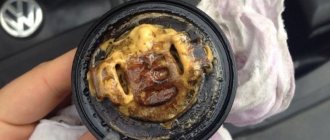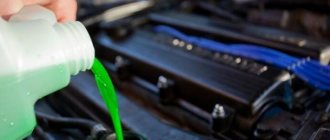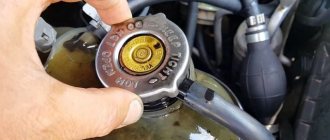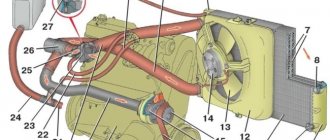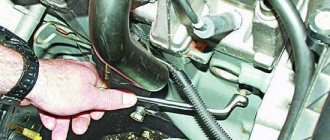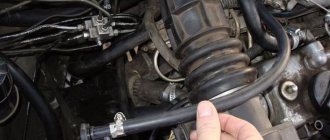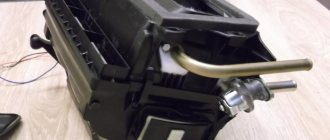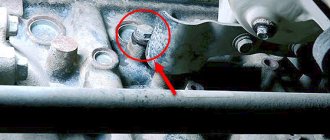One of the main systems of a car engine is the lubrication and cooling system. In normal and working condition, they are closed circuits, so the oil and antifreeze circulating in them do not mix. If the tightness of some elements is broken, oil may enter the coolant. If this happens, it is necessary to urgently determine and eliminate the cause, as well as thoroughly flush the cooling system.
- Cleaning agents
Water - Milk serum
- Fairy
- Powder machine
- Diesel fuel
Video: flushing the cooling system with diesel fuel
Why did antifreeze turn yellow?
antifreeze discoloration
lies in the accumulation of rust and scale in the car’s cooling system.
... If the color of the coolant turns
straw
yellow
, this is a signal that the dye has expired or that the engine has overheated.
Interesting materials:
Why is the praying mantis called that? What is the correct name for Bulgarian? What is absolute zero temperature? What is a balcony? What is the divisor of a number? What is called diameter? What is a Diphthong called in Latin? What is wavelength? What is email? What is the nth root called?
Flushing agents
Car owners resort to the following methods as cleaning agents.
Water
You need to prepare distilled or at least boiled water. This option can only be used if the cooling system is slightly contaminated. Water is poured into the radiator, after which the engine is heated to operating temperature and everything is drained. To get rid of the emulsion, you will have to repeat the procedure 5-6 times. This is an ineffective way to flush the system of oil, but it is the most affordable.
Flush the cooling system with water until clear liquid drains out.
Milk serum
You can use whey. Before use, the whey must be strained through cheesecloth to remove any clots and sediment present in it. Craftsmen recommend different periods of time for keeping the whey in the cooling system. Some drive with it for 200–300 km, others fill it up, warm up the engine and drain it.
If after draining the whey there are a lot of clots and oily formations, then it is recommended to repeat the cleaning procedure.
The serum is not very effective in the fight against oily deposits.
Fairy
Use Fairy or similar dishwashing detergent. Pour 200–250 grams of this product into a large amount of water, depending on the degree of contamination of the system, and stir. The engine is warmed up and left for 15–20 minutes.
If after draining there are a lot of impurities in the liquid, then the procedure is repeated. During washing, the detergent begins to foam strongly, so you need to monitor the condition of the expansion tank. This option helps to effectively remove oil from the system, but its disadvantage is the formation of a large amount of foam. It is necessary to rinse the system several times with water until the remaining detergent is removed.
During heating, detergents begin to foam strongly, so you need to monitor the expansion tank
Powder machine
This option is similar to using dishwashing detergent, so it also works well at clearing oil from the system. The advantage is that using an automatic powder produces less foam. When creating a solution, add 1 tablespoon of powder per liter of water.
Diesel fuel
This is the most effective folk method. Fill the system with diesel fuel, warm up the engine and drain the diesel fuel. The procedure is repeated at least twice, and before adding antifreeze, rinse with water.
Some people are afraid that diesel fuel may ignite or damage the pipes. Folk craftsmen claim that nothing like this happens and the method works very effectively. To warm up the engine faster, it is recommended to remove the thermostat while flushing it with diesel fuel.
Video: flushing the cooling system with diesel fuel
Special fluids
You can purchase special liquids for flushing the cooling system in the store. This is the best option for cleaning the cooling system from oil, but it is more expensive than using traditional methods.
Special liquids for flushing the cooling system can be purchased at any auto store.
Each such remedy has instructions according to which you must act. A certain amount of special liquid is poured into the system. Let the engine run for 30–40 minutes and drain, then flush the system with water.
Video: how to flush the cooling system from emulsion
Causes
The expansion tank of a VAZ is cracked.
As a rule, the driver finds out about such a problem as engine oil in the expansion tank of the coolant when he decides to check the level of antifreeze in the system. There may be oil residues on the neck, and the coolant itself may change its color or consistency. In addition, the refrigerant may develop a relatively unpleasant odor.
Engine lubricant enters the expansion tank with antifreeze
One way or another, you need to keep in mind that mixing lubricant and refrigerant is a very bad sign for the vehicle owner. Both consumables circulate through systems isolated from each other. Moreover, they are sealed, so mixing liquids should at least alert the driver. If consumables are mixed with each other, this means that the systems are no longer sealed, which can cause engine fluid to leak.
The most likely and common reason for the mixing of consumables, in particular the ingress of engine fluid, can be:
- occurrence of mechanical damage to the operation of the oil radiator or oil cooler;
- malfunction of the cylinder head (the block gasket has expired);
- The heat exchanger (oil cooler) gasket has exhausted its service life.
It should be noted here that it is at these points that the lubrication and cooling systems come into contact with each other. In an oil cooler, such contact is explained directly by the purpose of the device. In some vehicles, the engine fluid simply must be maintained at a certain temperature, as a result of which the vehicles are equipped with an oil cooler. The latter, in turn, directly interacts with the vehicle’s cooling system, where the refrigerant acts as a coolant.
Consequences of using poor-quality coolant
In addition, one of the important reasons is the inconsistency of the refrigerants that the driver pours into the system of his car. For example, the driver detected that the refrigerant level in the expansion tank was too low and found no other way out but to pour the first available antifreeze into the system. As you know, antifreeze manufacturers can use various additives in their products. If these substances are incompatible with each other, then when heated by the engine, they enter into a chemical reaction with each other.
Torn and expired oil cooler gasket
How to determine the mixing of engine fluid and coolant?
The following are the reasons why you can determine that oil and refrigerant have mixed in your car:
- When draining the antifreeze, you see a refrigerant that is quite good in color and consistency. But, when all the coolant (coolant) has practically drained, the so-called liquid of an incomprehensible dark color begins to come out of the system (what you may have previously noticed in the expansion tank).
- A liquid of unknown composition cannot mix with the refrigerant; it immediately floats on top of the consumable. In addition, individual particles of the substance, when floating in antifreeze, may have a convex shape.
- If you decide to try the “liquid” by touch, it will be easily smeared with your fingers and will not leave greasy marks. If you try to rub a good lubricant (for example, from a dipstick), then greasy marks will remain on your fingers.
Engine lubricant enters the expansion tank with antifreeze
- You can take a napkin and soak it in the substance in the expansion tank, then set it on fire. If the oil is in the Antifreeze, the napkin will start to burn. Not too much, but you will hear a slight cracking noise when it burns. If you soak a napkin in clean refrigerant and set it on fire, it will not burn. In turn, dipping a piece of paper into pure oil will burn very quickly.
- If engine fluid is mixed with refrigerant, soot clots will begin to form in the lubricant, and deposits may appear in the oil passages. As a result, the throughput of the oil filter will be significantly reduced.
- The oil filter can become clogged with mixing products, in particular with dense balls formed as a result of mixing. Such clots can subsequently completely clog the filter, as well as cause abrasive wear of the cylinders and bearings of the camshaft and crankshaft.
- Over time, the substance can cause increased engine corrosion.
- The antifriction properties of the lubricant will be significantly reduced.
- The oil film will become very unstable and will break too quickly.
Installation
Before installing a new gasket, you must thoroughly clean the surface of the block and head. The sealant and remnants of the old seal are completely removed. Cleaning must be done carefully so as not to damage the contacting surfaces.
Then install a new gasket, taking into account the position of the centering bushings. The hole with copper trim should be located between the third and fourth cylinders. Before installing the head, you need to make sure that the valves of the first cylinder are closed.
When installing the head, all bolts are placed in the technological holes. The central ones are twisted first, and then the side ones. Tightening must be done strictly with a torque wrench. First, the bolts are pulled with a force of 20 Nm, then 70-85. The next time, each bolt is pulled another 90 degrees.
Then the installation of hanging elements is carried out. These are a belt, pipes, spark plugs, wires, a fuel rail and other components.
A short introductory part
The expansion tank (RB) looks quite simple: cheap and cheerful. But despite this, it is impossible to simply take it and throw it out of the car. Such an insignificant, at first glance, detail may have its own problems, and there are many of them. Often they simply explode due to high pressure, and coolant begins to fill the entire engine compartment.
For this reason, you should not wait for the tank to manifest itself at the most inopportune time. If a problem is discovered, do not put off solving it indefinitely.
But before we figure out how to check the cap of the expansion tank of a VAZ 2110 (or any other model), let’s figure out why it is needed and what important role it plays. Maybe it will still be better without him?
DIY expansion tank repair
During operation, the expansion tank is constantly affected by deformation: the container contracts and expands due to temperature changes - this is its operating mode. At peak values, cracks appear on the walls of the tank. The problem can be solved in two ways: buy a new tank or repair the old one.
Expansion tank crack
The material used in the manufacturing process of expansion tanks does not react with any adhesives, regardless of brand. This suggests that it will not be possible to properly repair the tank by gluing it. Those car owners who decide to restore the capacity, as a rule, resort to the following methods:
Due to the constant exposure of the expansion tank to high pressure and temperature, cracks appear on the vessel over time
It is worth noting that cold welding and epoxy eliminate the problem only temporarily and you will still have to return to repairing or replacing the tank.
Some car enthusiasts are wondering what and how to repair cracks in the plastic housing of the expansion tank? To carry out the procedure at home you should:
How I found my ideal hair growth product
Hello dear! I want to share with you my solution to the sensitive problem of hair loss . The problems are very serious, at least for me. I would never have thought that this misfortune would touch me, especially at the age of 29 (read more...)
- clean the housing at the crack site with a clean rag or napkin;
- degrease the area with solvent and then dry;
- cut a piece of brass mesh with small cells along the length of the damage;
- apply a strip to the repair site;
- Using a heated soldering iron, solder the mesh to the edges of the crack so that a reinforced layer is formed over the entire area of the mesh;
- grind the seam;
- Apply putty, a layer of primer and paint.
The most common and affordable way to restore an expansion tank is soldering using a fine metal mesh
For the procedure discussed, you will need a soldering iron with a minimum power of 40 W and a flat tip. You can restore the seal of the tank using a special red Done Deal sealant, which is intended for plastic. Before applying the substance, the body is thoroughly cleaned and degreased.
Video: repairing the expansion tank by soldering
How to flush the cooling system. All ways
So, there are a lot of options for radiator flushing on the Internet: from really effective ones to crazy ones. We will list the most common:
They all have the right to life, but have their own advantages and disadvantages.
The most common, as well as the cheapest and least expensive washing option is water. Naturally, not from the tap, but purchased distilled water. It has minimal salt content.
Alas, water does not remove scale, grease and rust; it only washes sediment out of the cooling system and removes antifreeze residues. Distillate is used as a final rinse or when replacing antifreeze if the old fluid looked pretty good.
Lemon acid
Proportions: 200 g of citric acid per 10 liters of water.
Pour the selected mixture into the cooling system (to the maximum mark), warm up the engine. It will be more productive if you drive your car around the neighborhood for half an hour or even an hour, and only then drain the used fluid.
To refill, you can use a less concentrated mixture. After everything, rinse the system with distilled water and you can refill with new antifreeze.
Vinegar
Proportions: 500 ml of 9% vinegar per 10 liters of water.
Pour the solution into the expansion tank, run the engine at idle speed for 20 - 30 minutes, and then leave the car alone overnight. By morning, the vinegar water will do its job. You can simply drain it and flush the cooling system with distilled water.
Application of citric acid
Experienced car owners are well aware of the fact that the basis of all such cooling system cleaning products is citric acid. Why pay several thousand rubles and buy such cleaning liquids, if you can literally buy a small amount of lemon juice in the nearest store for 100 rubles and use it to clean the entire cooling system. The direct use of such improvised folk remedies is not particularly difficult, which allows you to significantly save on the operation of the car, and anyone, even a novice car owner, can carry out the necessary service.
If there is noticeable overheating in the car, the engine begins to run unevenly, then it is quite possible that it is time to clean the cooling system. The easiest way to do this work is on an overpass or in a garage pit, which will allow you to easily drain the old antifreeze. All you need is a small amount of citric acid and distilled water. It is necessary to add lemon juice to distilled water at the rate of 100 grams of chemical per 10 liters of water. The solution is thoroughly mixed and poured into the cooling system with drained antifreeze.
All that remains is to start the engine, warm up the engine to 90 degrees, this will allow all the liquid to be distributed throughout the system, then turn off the engine and leave the car for several hours. During this time, citric acid dissolves existing dense deposits, after which the liquid is drained, which after this procedure may have a rusty or black color.
The car owner will only have to pour new antifreeze into the system and bleed the pipes to get rid of air jams. The engine is started, checking the performance of the entire system, the engine must be properly cooled, and antifreeze must circulate first through the small and then through the large circuit. By doing this work yourself, you can solve all problems with the functioning of the cooling system for two to three years, and the engine will work correctly. At the same time, the car owner will avoid problems with engine overheating and possible serious breakdowns only due to the operation of the power unit at high temperatures.
Membrane replacement process
When the membrane wears out, the following types of work should be performed:
- disconnect the tank and drain;
- release pressure using the nipple;
- There is a membrane in the place where the pipeline is connected. The membrane flange is dismantled. Afterwards the holder is released;
- the membrane is removed;
- The inner surface of the expansion tank is checked for dirt and rust. If necessary, flushing is carried out;
- you need to know that the membrane is sensitive to oils. So it is unacceptable to use them as anti-corrosion agents on the inside of the case.
Looking for a leak
Loss of the sealed state of the heating system leads to a loss of pressure. By conducting a complete inspection of the heating device and pipe system, leaks can be detected. Leaks to the naked eye are determined by the accumulation of moisture at joints or holes with a characteristic white coating.
When inspecting, you should pay attention to the connecting elements, couplings at soldering points and direct connections to heating devices. A system with metal pipes may leak at longitudinal seams
Once a leak is discovered, it is worth taking care of its elimination. The joints are repacked, gaskets and gland seals are installed, with a thickness slightly greater than the previous one. If the pipeline is damaged, the damaged section must be replaced.
How often to flush the cooling system
The main question, of course, is how often this should be done.
The paradox is that the latest generations of antifreeze, according to manufacturers, do not need to be replaced for 3 to 5 years. And the newest types of liquids last up to 10 years. But this does not mean that you can forget about the cooling system for this period.
There are no uniform recommendations regarding the frequency of radiator flushing. Some car factories advise flushing after 3 years, others after 5 years. The mileage of the car also matters. On average, the cooling system of a new car should be flushed once every 3 years or after 75 - 150 thousand kilometers. There is no point in using chemicals more often; it can harm internal components.
However, extraordinary flushing is necessary if:
The cooling system should be flushed with distilled water every time the antifreeze is replaced.
Source
How to clean the expansion tank from rust
Internal cleaning is recommended at least once a year. It is best to do this after winter is over. A light indicator with a picture of a radiator helps determine the exact time. In addition, there are other signs by which one can judge the need for cleansing.
Systematic engine overheating and failures when starting it.
Precautions and washing nuances
When washing yourself, it is best to use special products that are selected depending on the contamination (oil, scale, rust). The use of most traditional methods will not be as effective as the use of special liquids.
Please note that folk remedies are not always cheaper than special ones. In addition, their application takes longer. For example, to clean the system from foam after using dishwashing detergent, you will need to rinse it at least 10 times.
To flush the engine using any means, you must use distilled or boiled water. If you take tap water, scale will form during heating.
There are many ways to flush the cooling system if oil gets into it. Each of them has its own advantages and disadvantages. In order to prevent serious consequences, it is necessary to periodically monitor the condition of the antifreeze and, when the first signs of oil getting into it appear, eliminate the causes and flush the system.
